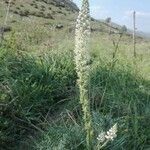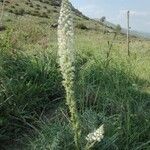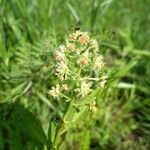Annual or biennial herb, erect or sprawling, up to 80 cm tall. Stem ribs somewhat scabrous. Leaves narrowly obovate to elliptic, 17–40 mm long, 4–15 mm wide, entire or some 3-lobed, shortly petiolate, glabrous or glabrescent. Raceme up to 15 cm long; bracts narrowly ovate, 2–3 mm long, glabrous, persistent; pedicels 4–6 mm long, the ribs scabrous. Sepals 6, 2–4 mm long, oblong, reflexed in fruit. Petals 5, c. 4 mm long, white or pale yellow; upper petal deeply 9–14-lobed; lateral petals 6–10-lobed, linear-spathulate; appendage of claw ovate, 2 mm long, ciliate. Disc 2.5 mm wide, velvety. Stamens 20–22; anthers 1.2 mm long; filaments 3 mm long, falling off after flowering. Ovary 3-angled, 3-dentate. Capsule 8–10 mm long, 4–5 mm wide, scabrous. Seeds rugose, grey-brown, dull.
Herbs usually annual, to 40 cm tall, glabrous. Stem branched. Leaves subsessile, spatulate or lanceolate to elliptic-oblong, entire or toothed to parted, papery. Flowers in terminal racemes; white or light yellow, or orange-red when cultivated, very fragrant. Sepals 6, narrowly spatulate, 2.5-4 mm, shorter than pedicel. Petals 6, clawed at base, lower 2 entire, lateral 2 digitate, upper 2 digitate with few segments and equaling sepals. Stamens 17-20; filaments subulate. Carpels 3. Capsule pendulous, subglobose or urceolate, 3-angled, ca. 1 cm. Seeds black, shiny, 2-2.5 mm; testa rugose. 2n = 12.
An annual herb. It can be erect or lie over. It grows 45 cm high. The leaves are 3-7 cm long by 2-3 cm wide. The lower leaves are entire and sword shaped. The upper leaves have 3 leaflets or lobes. The flowers have a sweet smell. They are yellowish-white. They are in groups up to 50 cm long in the axils of leaves or at the ends of branches. The fruit is an almost round capsule. It hangs down. The seeds are black.
With chiefly undivided lvs, and very fragrant fls on pedicels twice as long as the cal, the 6 pet greenish or greenish-yellow, with numerous filiform-clavate appendages, occasionally escapes from cult.



